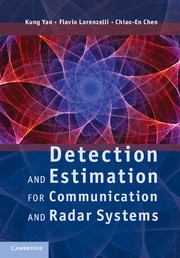Book contents
- Frontmatter
- Dedication
- Contents
- Preface
- 1 Introduction and motivation to detection and estimation
- 2 Review of probability and random processes
- 3 Hypothesis testing
- 4 Detection of known binary deterministic signals in Gaussian noises
- 5 M-ary detection and classification of deterministic signals
- 6 Non-coherent detection in communication and radar systems
- 7 Parameter estimation
- 8 Analytical and simulation methods for system performance analysis
- Index
1 - Introduction and motivation to detection and estimation
Published online by Cambridge University Press: 05 July 2013
- Frontmatter
- Dedication
- Contents
- Preface
- 1 Introduction and motivation to detection and estimation
- 2 Review of probability and random processes
- 3 Hypothesis testing
- 4 Detection of known binary deterministic signals in Gaussian noises
- 5 M-ary detection and classification of deterministic signals
- 6 Non-coherent detection in communication and radar systems
- 7 Parameter estimation
- 8 Analytical and simulation methods for system performance analysis
- Index
Summary
Introduction
The second half of the twentieth century experienced an explosive growth in information technology, including data transmission, processing, and computation. This trend will continue at an even faster pace in the twenty-first century. Radios and televisions started in the 1920s and 1940s respectively, and involved transmission from a single transmitter to multiple receivers using AM and FM modulations. Baseband analog telephony, starting in the 1900s, was originally suited only for local area person-to-person communication. It became possible to have long-distance communication after using cascades of regeneration repeaters based on digital PCM modulation. Various digital modulations with and without coding, across microwave, satellite, and optical fiber links, allowed the explosive transmissions of data around the world starting in the 1950s–1960s. The emergence of Ethernet, local area net, and, finally, the World Wide Web in the 1980s–1990s allowed almost unlimited communication from any computer to another computer. In the first decade of the twenty-first century, by using wireless communication technology, we have achieved cellular telephony and instant/personal data services for humans, and ubiquitous data collection and transmission using ad hoc and sensor networks. By using cable, optical fibers, and direct satellite communications, real-time on-demand wideband data services in offices and homes are feasible.
- Type
- Chapter
- Information
- Publisher: Cambridge University PressPrint publication year: 2013



